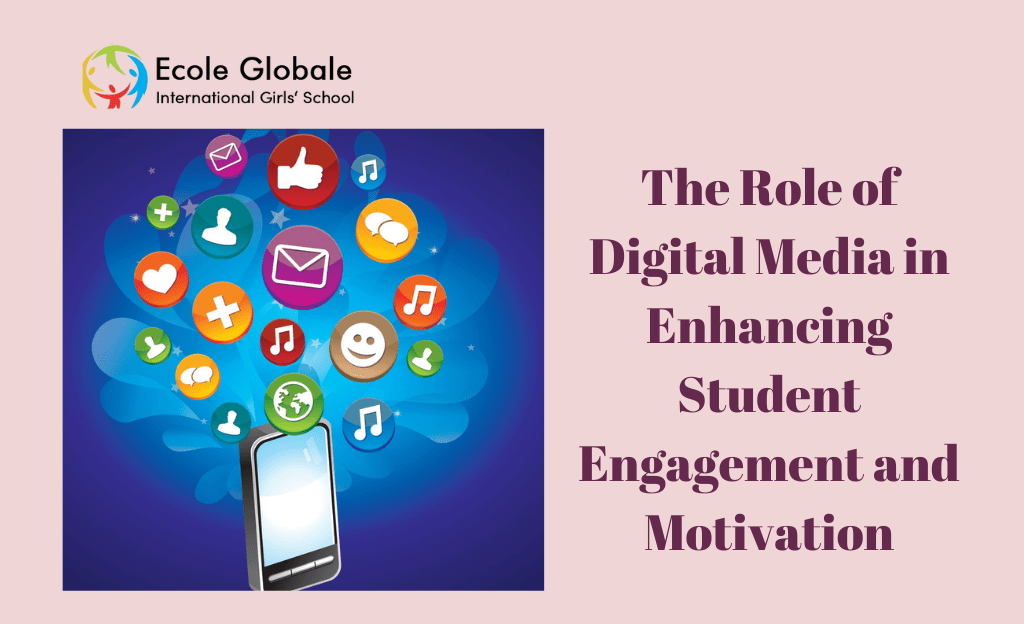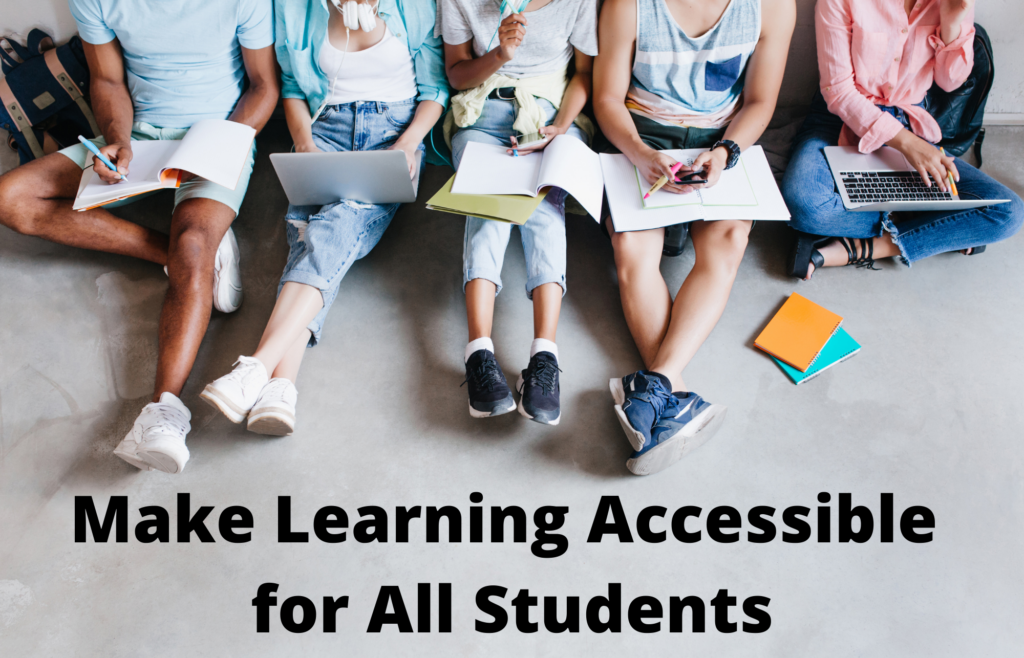Digital media is a group of digital technologies used in processing and consuming information. Digital media includes smartphones, e-readers, social networking sites, and the Internet. The concepts we tackle to explain digital media are being able to locate resources online, staying in contact with family and friends via social media, and having an online presence for yourself or an organization. Digital media plays a crucial role in enhancing student engagement and motivation by providing interactive and dynamic learning experiences.
This article will explore the role of digital media in education and how to enhance student engagement and motivation using them.
Also read: Schools in India
Enhancing Student Engagement

Interactive learning experiences
Digital media can create interactive learning experiences by allowing you to incorporate different types of media- text, audio, and video into your course content. It will help students learn better because they can visualize concepts rather than just reading about them or hearing about them from their teacher. Interactive activities also help students retain information better than if they were not involved in them at all.
Gamification
In the context of education, gamification can be defined as the use of game elements in non-gaming contexts. These elements include competition, collaboration, rules, feedback, scores, and leaderboards. Gamification promotes a higher level of participation; players have goals to achieve and receive rewards when they advance toward those goals. They also have challenges that need solving along the way which provides enjoyment while learning new concepts or skills.
Gamification is a relatively new concept that has gained popularity over recent years due to its effectiveness in increasing engagement among students who otherwise may not engage with traditional learning methods.
Virtual reality
According to the best boarding schools in India, Virtual reality (VR) is one such technology that has attracted considerable attention from educational researchers. VR offers educators a new way to communicate ideas and concepts to students. It can be used as an immersive environment where students can explore new environments or situations.
Additionally, VR can be used to represent abstract concepts such as emotions or complex social interactions. Thus, it is not surprising that VR has been applied in many fields- psychology (e.g., emotional intelligence training), engineering (e.g., product design), medicine (e.g., surgical simulations), language learning (e.g., foreign language immersion), research (e.g., data visualization), marketing, etc.
Personalized learning
As technology has advanced over the years, so has personalized learning with tools like adaptive learning software that allow teachers to create individualized lessons based on each student’s strengths and weaknesses. Personalized instruction empowers students by allowing them freedom over how they learn instead of being limited by traditional teaching methods.
Adaptive learning technology
Teachers can use technology to create personalized learning experiences for students, which build on each child’s unique interests, skills, and needs. The use of adaptive learning technology helps teachers personalize instruction for students by adjusting lesson plans and activities according to each student’s progress throughout the course.
Collaborative learning tools
Collaborative learning is student interaction that encourages teamwork and sharing ideas to complete assignments or solve problems. Collaborative learning tools allow students to work together online while they complete projects. These tools provide a more social environment than traditional classrooms, which may help decrease feelings of isolation among students struggling socially or academically.
Access to real-world examples
Digital tools allow teachers to share real-world examples with students. Students can get a glimpse into what life might be like as an engineer or doctor. It will help them relate better to what they are learning at school, making it more interesting than just reading definitions from textbooks or listening to lectures by their teachers. Instead of being confined to a textbook or lecture video, learners can now explore subjects from multiple perspectives, gain insight from experts and collaborate with their peers in real time. It can be done through:
- Use of video content
- Real-life simulations
- Online databases and archives
Enhancing student autonomy
One way in which technology can enhance student autonomy is by allowing students to control their learning path. It enables them to take charge of their learning process by choosing what they want to learn about, when they want to learn it, and how they want to learn it.
Self-directed learning
Self-directed learning is an important skill that students need to develop as they progress through their education. While teachers can guide them and provide structure, students must be able to learn independently, think critically, and make their own decisions. This ability is becoming more important as technology becomes more integrated into the classroom.
Personalized learning paths
It means that each student will follow their path to learn certain subjects. Students can choose what they want to study when they want to study, how much time they want to spend on each subject, and how much effort they want to put into each subject. In this way, students can learn at their own pace and have more control over their learning process.
Encouraging student-to-student collaboration
Students are likelier to engage and be motivated when they feel like their peers are listening. When students have the opportunity to share their work with their peers, they feel more engaged and encouraged to share their knowledge and skills.
Digital technology can allow students to share their work with a wider audience, encouraging them to collaborate with other students online and in person. It helps students develop critical thinking skills they can use throughout their academic careers.
Making learning accessible
Furthermore, digital media allows students to study anywhere they want – whether it’s in the library or at home – rather than being restricted to classrooms or lecture halls only. It gives them more freedom to explore different learning styles and find out what works best for them.
One challenge is making learning more accessible for students who may not have access to technology outside of school hours. It is a particular problem for students living in remote areas where internet access is limited or non-existent. In these situations, it can be difficult for teachers to provide necessary resources like online materials or activities that help students learn new concepts or skills.
Fortunately, some solutions can help teachers overcome this challenge while still providing quality instruction to their students.
- Use of mobile devices
- Access to digital resources
- Online learning platforms
Challenges in the implementation of digital media
Technical issues
Despite many benefits associated with using digital media as tools for teaching and learning purposes, there are some challenges associated with it, particularly in developing countries such as India where access to technology is still limited.
Teacher training
Teachers often lack adequate training in effectively using digital tools for learning purposes. It can result in teachers not knowing how best to use these tools or being unsure about what resources are available for them. In addition, there is often a lack of access to technology in schools causing teachers without access to these resources from home or other sources such as libraries. It can result in teachers having limited access when compared with their students with access to it at home or through their parents’ phones etc.
Equity issues
Since digital devices are not equally distributed across populations, equity issues arise when different groups have access to different types of resources.
Bridging this gap would allow them to participate in online learning communities where they could collaborate with their peers from other schools and access additional resources such as videos, articles, and other materials created by teachers or learners.
Conclusion
The intersection of technology and education has become more prominent in recent years. Using technology in the classroom effectively enhances student engagement, improves learning outcomes, and increases student achievement.
In today’s society, nearly everyone is connected with technology. Students are constantly using their phones and computers during their free time and at school as well. Digital media can be used to engage students in learning by incorporating it into the classroom, which will help them become better learners not only inside the classroom but also outside of it as well.
For any queries related to parenting, schooling, or any students-related tips, click here to check out our latest blogs.








